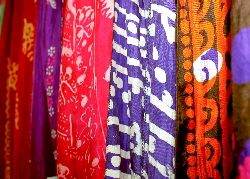|
 Silk is well known for taking dyes well and these can produce vibrant colours. Silk is also lustrous and reflects light, which gives the colours an added luminosity. Silk is well known for taking dyes well and these can produce vibrant colours. Silk is also lustrous and reflects light, which gives the colours an added luminosity.
A. Choosing which type of silk to dye
B. Mordanting silk (next page)
C. Dyeing silk with natural dyes (next page)
D. Advanced silk hanky dyeing [coming soon]
E. Silk painting with natural dyes extracts [coming soon]
A. Choosing which type of silk to dye
Most people are familiar with silk fabrics and silk scarves. You can also buy silk yarn for knitting, weaving and embroidery, and silk fibres that have not been processed into yarn, such as silk tops and degummed cocoons.
a) Silk fabric
There are many types of silk fabrics, of which Pongee 5 and Habotai 8 are the most popular. Before dyeing a larger piece, it is best to experiment with a small piece of fabric first to see how it reacts to being dyed. Some commercial silks are covered with Teflon and do not take up the dye well, whilst others may have their lustre damaged in the dye pot.
• Pongee 5 is the most popular silk fabric and is used for scarves as it has excellent drape, Pongee and chiffon are thin and translucent which can make them difficult to get dark colours. If you are painting the silk, it may also be difficult to see complex designs.
• Habotai 8 is traditionally used for silk painting. It is more substantial than Pongee 5, therefore the colours appear deeper and darker and you will get better definition to designs. It has good drape and it is also used in scarves.
• Habotai 10 is denser than Habotai 8 and can be used for making clothes.
• Dupion is very substantial and has some texture. Dupion silk can be used for making waistcoats, patchwork quilts, furnishings and experimental work.
• Silk noil fabric is very textured and takes dyes well.
• Silk garments are not easy to dye, as the thread used for sewing is often not made of silk and therefore unlikely to take the dye well. Some silk garments are ‘dry clean’ only and cannot be safely put in the dye pot. Bear in mind that a large wet garment is heavy to lift from the pot.
• Silk scarves are usually hemmed with silk thread, however sometimes other threads that don’t take the dye well are used. Buy your scarves from a reputable supplier and test one scarf before investing in a larger batch.
b) Silk yarns
• Thicker silk yarns, for example Double Knit (DK) silk knitting yarns, are easier to dye than fine yarns.
• Finer silk threads used for weaving and embroidery can get tangled in the dye pot. You can prevent this by placing several ties on the silk yarn.
• If you are dyeing very fine yarn, as well as using several ties, place a large stainless steel spoon through the centre of the hank and keep it there while mordanting and dyeing. Be very careful when moving the fine yarn inside the pot.
• Make sure the yarn is degummed. Most commercial silk yarn is degummed and feels soft, whilst gummed silk feels a little stiff.
c) Silk fibre
Silk fibres include silk hankies and mawata caps, mulberry and tussah silk tops, silk bricks, degummed silk waste, degummed silk cocoons, and other types of silk that have not been processed into yarn or woven into fabric.
• Silk hankies and silk caps are the easiest type of silk fibre to dye, they take the colour very well and are easy to handle inside the dye pot.
• Silk tops and silk bricks can become a little compacted during the dyeing process. If you want to use your silk tops or silk bricks for making silk paper this is not a problem. If you want to use the silk tops for spinning, you may find it easier to spin the silk first and then dye the spun yarn. Alternatively, handle the tops as little as possible during mordanting and dyeing, and try spinning the dyed top from the fold.
• Tussah silk has the reputation of being difficult to dye. This is not true as the tannin that gives the honey colour to the tussah silk is an advantage when using natural dyes. The honey undertone also gives greater depth to the colour. The only advantage of dyeing mulberry silk instead of tussah is to achieve purer colours as mulberry silk is white to start off with.
• De-gummed versus gummed silk: When the silk is unwound from the cocoon it has both silk protein (fibroin) and the glue (sericin) that keeps the cocoon together. The sericin makes the silk stiffer and it can also prevent the dye from penetrating the fibres. Most silk sold commercially has been degummed (i.e. the sericin has been removed). If you are not sure whether a certain silk fibre has been degummed or not, you can ask your supplier. It is easier to dye de-gummed silk, for example mulberry or tussah silk tops, silk bricks, silk hankies and silk caps. It is also possible to dye some types of gummed silk, such as silk cocoon, silk carrier rods and gummed silk waste. The colour may not be as wash fast in gummed silk, but if you are turning your silk into an art work that is not going to be washed, this may not matter.
B. Mordanting silk (next page)
C. Dyeing silk with natural dyes (next page)
D. Advanced silk hanky dyeing [coming soon]
E. Silk painting with natural dyes extracts [coming soon]
And back to Mordanting Wool and Cotton etc.
Top of page
|